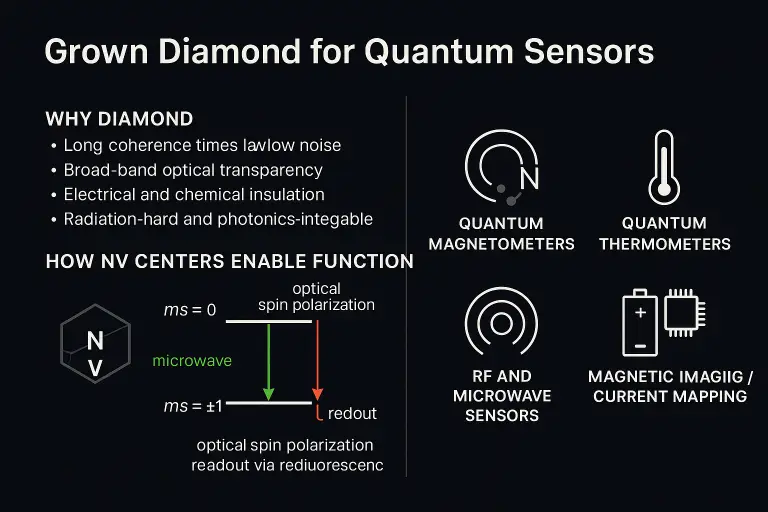Quantum sensor needs grown diamond
Image Credits: Bosch
Lab‑grown diamond is the most versatile solid platform for room‑temperature quantum sensing. It combines a rigid, low‑noise crystal lattice with exceptional optical transparency and electrical insulation, so spins can be addressed cleanly with light and microwaves while background noise is suppressed. Unlike fragile cryogenic platforms, high‑purity CVD diamond supports long spin‑coherence at ambient conditions, can be isotopically engineered (e.g., ^12C enrichment) to further extend coherence, and is robust against radiation, chemicals, and heat. This stability lets quantum devices operate in the lab and in the field—on chip, in clinics, factories, vehicles, or space—without sacrificing sensitivity or lifetime.

Why grown diamond unlocks quantum sensing
Engineered NV centers: Nitrogen‑vacancy (NV) defects in diamond form optically addressable spin qubits (spin‑1, typically NV⁻) that polarize with green light and read out via red fluorescence (ODMR).
Long coherence at room temp: High‑purity and ^12C‑enriched diamond minimizes spin noise, enabling millisecond‑scale T₂ with decoupling—boosting sensitivity without cryogenics.
Photonic friendliness: Wide UV–IR transparency and high refractive index support integrated waveguides, resonators, and fiber coupling for compact modules.
Electrically insulating, thermally conductive: Reduces cross‑talk and removes heat from drive fields, allowing stable, high‑power operation.
Radiation‑ and chemically‑hard: Maintains calibration and surface quality in biomedical, industrial, and space environments.
What quantum functions improve
Magnetometry: Vector magnetic‑field sensing from nT→pT scales; wide dynamic range and imaging with NV ensembles.
Thermometry: Temperature readout from shifts in the NV zero‑field splitting enables milli‑kelvin‑level sensitivity near devices or inside tissues.
Electric‑field/strain/pressure sensing: NV energy levels respond to local stress and fields for precision metrology and materials diagnostics.
Microwave/RF detection: Frequency‑selective field sensing and spectrum analysis via spin transitions.
Where to use it
Semiconductor & battery R&D: Current mapping in ICs, electromigration studies, hotspot and thermal‑runaway diagnostics.
Medical & life sciences: Nanoscale thermometry and magnetometry near cells, microfluidics, and contrast‑agent‑free MRI/NMR enhancements.
Navigation & defense: Compact, low‑drift magnetometers for GPS‑denied navigation, UXO detection, and anomaly mapping.
Aerospace & space: Radiation‑hard quantum sensors for space weather, spacecraft health, and planetary magnetism.
Industrial sensing: Inline monitoring of motors, power electronics, and additive‑manufactured parts.